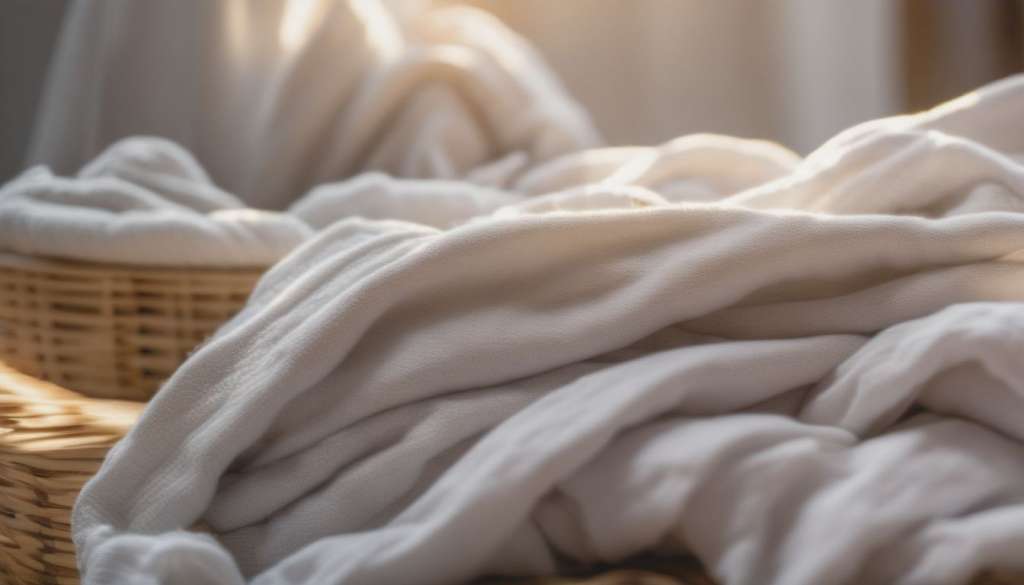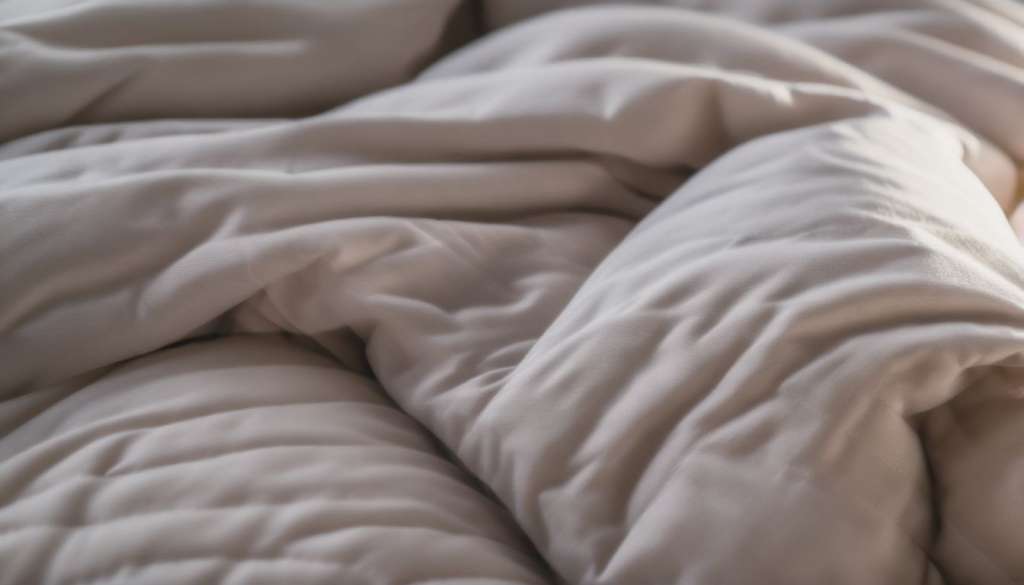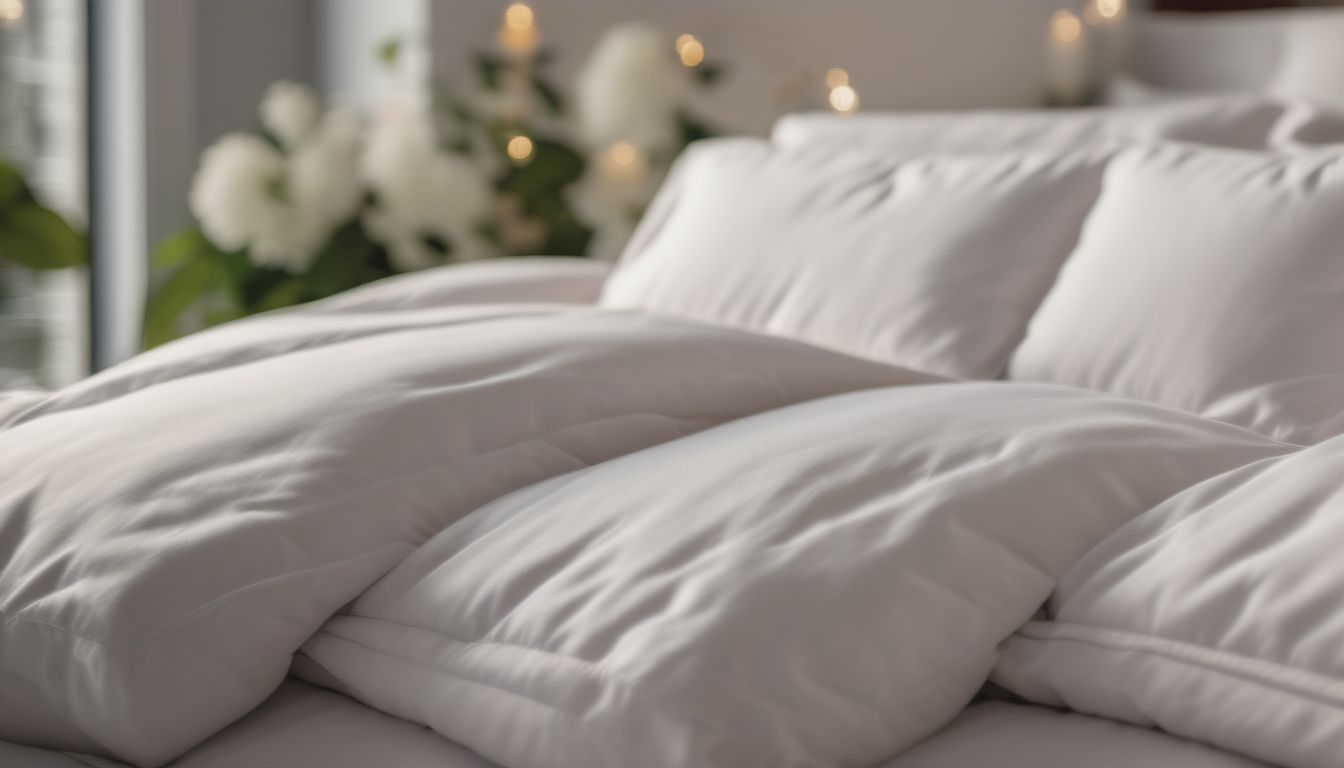Have you ever noticed a musty, damp odor coming from your down comforter, even after washing? This unpleasant smell can linger in the filling and fabrics, causing discomfort and disrupting sleep.
Fortunately, there are ways to banish funky odors from your bedding for good. This beginner’s guide covers everything you need to know about keeping down comforters fresh, clean, and free of lingering smells.
An Introduction to Down Bedding
Before diving into washing methods, let’s review some down comforter basics.
What Is a Down Comforter?
A down comforter is a type of quilt filled with the fine, fluffy clusters and plumules that insulate birds. This natural filling provides exceptional warmth and loft compared to other bedding materials.
The outer shell of a down comforter is typically made from lightweight fabrics like cotton, cotton sateen, or Egyptian cotton. These breathable materials allow effective air circulation to maintain the fluffiness of the down filling.
Why Proper Care Is Crucial
The delicate materials used in down bedding require specialized cleaning methods to prevent damage, clumping of the fill, and odor retention.
Neglecting these items through improper washing, inadequate drying, and poor storage can allow mold, mildew, and bacteria to take hold, resulting in permanent musty smells.
Understanding proper care techniques is key to safeguarding your investment and ensuring your comforter remains fresh and free of funk for years to come.
What Causes Down Bedding to Smell After Washing?
Several factors during the laundering process can lead to lingering odors in down comforters even after cleaning. Identifying the source of the smell is the first step toward banishing it for good.
Moisture Retention
The #1 culprit behind smelly down bedding is moisture retention in the filling and fabrics after washing. Failing to adequately dry all inner and outer materials allows dampness to linger. This creates an ideal environment for odor-causing mold and bacteria to multiply.
Even traces of moisture trapped deep in the baffles can lead to bad smells over time. Thorough drying is critical to prevent this.
Bacteria and Mold Growth
Dampness also enables mold spores and bacteria to rapidly multiply. These microorganisms release smelly waste products and gases as they feed on organic materials in dirt, sweat, and body oils trapped in the fibers.
Once established, these odor-producers are difficult to eradicate fully. Preventing moisture retention and using sanitizing detergents inhibits them from taking hold in the first place.
Detergent Residues
Laundry products themselves can also be to blame for lingering scents between washes. Detergent residues and fabric softener buildup on fibers can make comforters seem smelly or musty, especially if non-removable fragrance products are used.
The Impact of Smelly Bedding on Health and Comfort
Musty, dirty odors coming from bedding can cause more than just unpleasantness. There are physical health and comfort impacts to consider as well.
Allergen Concerns
The mold, bacteria, dust mites, and other allergens that grow readily in damp, soiled bedding can trigger reactions in those prone to allergies or asthma. Wheezing, sneezing, coughing, and sinus irritation are common results.
Children and the elderly may be most vulnerable to these health effects, but even those not normally sensitive can develop problems from constant exposure to irritants hiding in smelly down items.
Disrupted Sleep
Trying to sleep surrounded by unpleasant and unhealthy odors is challenging for anyone. The irritants and stench can make falling and staying asleep difficult, resulting in fatigue and mood disturbances – especially for those sharing a bed.
Step-By-Step Washing Guidance
Now that you know what makes down bedding smell bad after washing, let’s explore the proper care methods that keep comforters fresh between cleanings.
1. Set Washer to a Gentle Cycle
The vigorous agitation of regular wash settings can damage delicate down materials. This also reduces the loft and causes hard clumps to form.
Instead:
- Set your washing machine to the gentle or delicate cycle to minimize rough treatment
- Use cool water settings below 80°F if possible
- Skip the wash and rinse spin cycles to prevent cramming or tangling fill
2. Wash with Specialized Detergent
Standard laundry soaps often contain dyes, whiteners and strong fragrances that stick to down fibers causing residue buildup and scent retention over time.
For best results, choose a fragrance-free and biodegradable down-specific detergent. These are formulated for delicate materials using grease-cutting enzymes and microbe-inhibiting ingredients instead of perfumes. Some top options include:
- Nathan Sports Wash
- Granger’s Down Wash
- OUT Fabricare Down Cleaner
Avoid products with optical brighteners as these can leave visible detergent deposits on fabrics.
3. Rinse Thoroughly
It’s critical to rinse away all suds, soils and cleaning product residues from the inner and outer layers after washing. These can become food sources for odor-causing mold and bacteria otherwise.
Most washers automatically add an extra rinse cycle. But for heavily soiled items, do a manual rinse as well until water runs clear.
Vinegar can also be added during the final rinse to help remove traces of smelly detergent deposits. The acidic white distilled variety works best for this.
Follow Proper Drying Methods
Moisture retention is public enemy #1 when it comes to preventing odors in down materials. That’s why proper drying techniques are so vital after each wash.
Effective Ways to Dry Down Bedding
- Large commercial dryers – These heavy-duty machines get hot enough to fully dry all inner and outer layers of washed items. Use low heat below 180°F.
- Natural line drying – Hang items outdoors if weather permits to air dry thoroughly. Direct sunlight naturally sanitizes as well.
- Tennis balls – Adding a couple of these to a home dryer helps break up knots and ensures fill is fully dried.
- Second cycle – Run thick comforters for a second drying cycle to remove all traces of moisture if needed. Check that the innermost fill layers are completely dry to be sure.
Failing to get down materials 100% dry provides the perfect playground for mold, bacteria and dust mites that cause stinking odors over time.

Preventing Odors Through Proper Maintenance
Developing good comforter care habits between washes is just as vital as cleaning methods for keeping odors at bay.
Wash Regularly
Don’t just wait until visible stains or strong smells develop to launder Down bedding. Follow a consistent cleaning schedule based on usage frequency.
- Wash pillows: Every 6 months
- Wash comforter covers: Every 2-3 months
- Wash down comforters: Every 12 months
This prevents the gradual buildup of oils, sweat and dirt that bacteria feed on. Schedule more frequent laundering if you sleep with pets or are in a humid environment.
Maintain Freshness Between Washes
- Avoid eating in bed – Crumbs attract moths that can damage down and produce musty smells from larvae droppings.
- Make the bed daily – Allow the fill to loft fully so air circulates to dry any night sweat.
- Use mattress pads and pillow protectors – These shield comforters from body oils and fluids that create stains and odors over time.
- Hang outdoors – Letting comforters air out fully in sunlight periodically helps dry and freshen the materials.
Store Properly Between Uses
Give washed down bedding the best chance to remain fresh and odor-free by storing properly after drying.
- Place items into large breathable cotton storage bags
- Avoid plastic containers or vacuum packing which trap moisture
- Store in a cool, dry place like a linen closet
- Add cedar blocks or sachets to repel moths
- Fluff fill periodically while stored to prevent clumping
Proper storage stops musty smells from developing while providing the right conditions to prevent new mold and bacteria growth.
How to Remove Existing Odors From Down
If funky smells develop between cleanings, don’t worry. There are some simple and natural DIY odor elimination tricks you can try at home first before taking items for professional laundering.
Vinegar Soak
White distilled vinegar effectively helps banish lingering odors from down materials without harming fabrics. It’s antibacterial properties even hinder future smells from taking hold.
Follow these steps for treating a smelly down comforter at home with vinegar:
- Fill bathtub with the hottest tap water safe for fabrics
- Add 2 cups vinegar and agitate water to combine
- Submerge comforter fully ensuring fill is soaked
- Let soak 30 minutes up to a few hours
- Rinse in shower 2-3 times until vinegar smell dissipates
- Dry thoroughly immediately after
This quick vinegar soak works wonders to freshen a light to moderately smelly down comforter between washes.
Baking Soda Deodorizer
Baking soda absorbs and neutralizes musty vapors with its alkaline properties. Lightly dusty this versatile powder onto fill through the shell before hanging outdoors. Over a few hours, smell should lift. Vacuum remnants out afterward.
While vinegar and baking soda make economical and effective DIY odor remedies for washed down items, severe smells may require professional cleaning.
Professional Down Comforter Cleaning
For severely soiled, stained or smelly down comforters that require intensive treatment, professional laundering services specialize in delicate restoration techniques.
Dry Cleaning vs Home Washing
Dry cleaners use formulated liquid solvents in a contained system without water to deep clean fabrics. This intensive process removes embedded oils, soils and odors without shrinking or damaging delicate down materials.
Home washing even in cold gentle cycles leaves more room for error that can result in failed odor removal. But professional services ensure powerful cleaning.
The drawback is cost. While dry cleaning is highly effective, charges often start around $100+ for a King down comforter and go up depending on size.
Choosing a Quality Professional Cleaner
Take care when selecting a vendor for cleaning pricey down items. Check reviews and ask around for reliable referrals. Good signs of a quality establishment:
- Specialized in delicates like down, leather, silks
- Uses top machines and solvents
- Fully insured if damages occur
- Provides itemized pricing upfront
- No bait-and-switch tactics
A reputable dry cleaner invests in proper training, equipment and techniques that reflect in exceptional service for items like high-end down comforters.
Keeping Down Comforters Fresh Long-Term
Preserving that fluffy loft and signature softness that quality down is cherished for depends on diligent care between cleanings.
Restore Lost Loft
Lofty down that gently billows around your body provides blissful comfort and warmth in bedding. But through regular use and compression, it can lose that desirable fluffiness.
revive flattened down clusters:
- Hang outdoors and let air fully fill all baffles
- Machine dry with tennis balls to break up clumps
- Use fingers or a pointed tool to gently poke and redistribute flattened spots
Prevent future flattening:
- Allow the filled comforter to fully re-loft after use before storage
- Store loosely in breathable bag without compression
- Shake and redistribute the down every 2-3 months
Hands-on fluffing combined with excellent moisture control keeps down bedding springy and voluminous for the long haul.
Use Light Fragrance Products Wisely
While strong detergent perfumes and residues can make down smell unpleasant, you may wish to add a subtle fresh scent naturally between washes.
The key is using only light, non-synthetic fragrance products formulated for delicates. These dissipate without leaving lingering sticky residues.
Some safe options include:
- Down-safe scented detergents – Granger’s, OUT
- Essential oil sprays – Lightly mist onto outer shell only
- Cedar blocks – Place a sachet in storage bags
- Dried lavender – Include small sachet packets with comforter
Refreshing light scents gives your bed a spa-like feel without risks of skin irritation, fabric damage or intensifying existing odors from residue buildup when used judiciously.
Environmental Factors Affecting Down Odors
Ambient conditions around stored down bedding can accelerate odor issues. Monitoring factors like humidity and temperature helps preserve freshness.
Humidity Hurts
Moisture is the mortal enemy of down materials. When humidity levels climb over 65%, dust mites, mold and mildew thrive, breaking down feathers and generating stinky waste products.
Prevent this seasonal issue through:
- More frequent hot water washing
- Fans and dehumidifiers near storage areas
- Adding silica packs to storage bags
- Periodic hanging outdoors to fully dry
Controlling ambient moisture is critical for keeping down smelling clean, whatever the climate or weather.
Temperature Troubles
Selecting wash water that is too hot also enables shriveling and clumping of down fibers so they resist drying fully. This provides a perfect home for odor-producers.
Aim for a maximum temperature of 105°F (40°C) in washing cycles. This allows thorough cleaning without risk of heat damage.
Getting the wash and dry temperature right ensures no lingering moisture while removing soils for the freshest down bedding possible.
Conclusion: Caring Properly for Down Finds Sweet Dreams
Maintaining the exceptional comfort, warmth and longevity quality down bedding offers means taking proper care not to damage delicate fibers. Skipping short-cuts with washing, neglecting thorough drying, and improper storage quickly leads to permanent funky odors from moisture-loving microbes. But with the right techniques, your investment stays fresh, clean and free of smells for years.
While the recommended methods take a bit more diligence compared to tossing standard sheets in the laundry, they ensure your down keeps providing blissful comfort. Applied consistently, you can enjoy sweet dreams without getting woken by “wet dog” smells from your bedding. Instead, look forward to slipping between freshly fluffed covers offering the welcoming warmth only down provides after conscientious care. So implement the above guidelines, and soon your nose will let you drift off the second your head hits the pillow.

Frequently Asked Questions
What causes down comforters to smell even after washing?
There are a few common culprits behind lingering odors in down bedding after laundering:
- Moisture retention in the down filling or fabrics allows mold and bacteria growth
- Residues from laundry detergents get trapped in the materials
- Bacteria and dust mites generate waste products and gases that cause smells
How can I get musty smells out of my down comforter at home?
Try these DIY odor removal methods before taking it for professional cleaning:
- Soak in a vinegar bath – the antibacterial acidic helps kill smells
- Sprinkle baking soda directly on the fill and vacuum out after a few hours
- Hang outdoors in sunlight – the UV rays naturally sanitize
Should I wash or dry clean my down comforter?
For routine cleaning every year or so, washing at home on a gentle cycle with down-specific detergent is fine. But for severe soiling, odors or stains, take it for professional dry cleaning. The intensive process lifts embedded oils and smells from down clusters without damage.
How often should I wash my down bedding?
To prevent gradual buildup of oils and dirt that worsen smells, maintain this schedule:
- Down pillows – Every 6 months
- Down comforters and blankets – Every 12 months
- Comforter covers – Every 2-3 months
What temperature should I wash and dry down materials?
Use a cool wash setting below 105°F (40°C) to prevent heat damage to delicate down clusters. For drying, medium heat below 180°F is ideal to fully dry both inner and outer layers without shriveling feathers.
Why does my down comforter lose fluffiness and go flat?
Regular compression during use and between washes deflates the delicate three dimensional structure of down fibers. To restore and maintain loft:
- Vigorously shake and redistribute flattened sections
- Allow to fully re-expand after washing before storage
- Store in large loose bags, avoid folding or compression
How can I keep my comforter smelling fresh between washes?
- Allow fill to completely air dry after use by fully making the bed
- Use lightweight down-safe scented sprays instead of heavy fragrances
- Store with natural smell absorbers like cedar chips or charcoal








